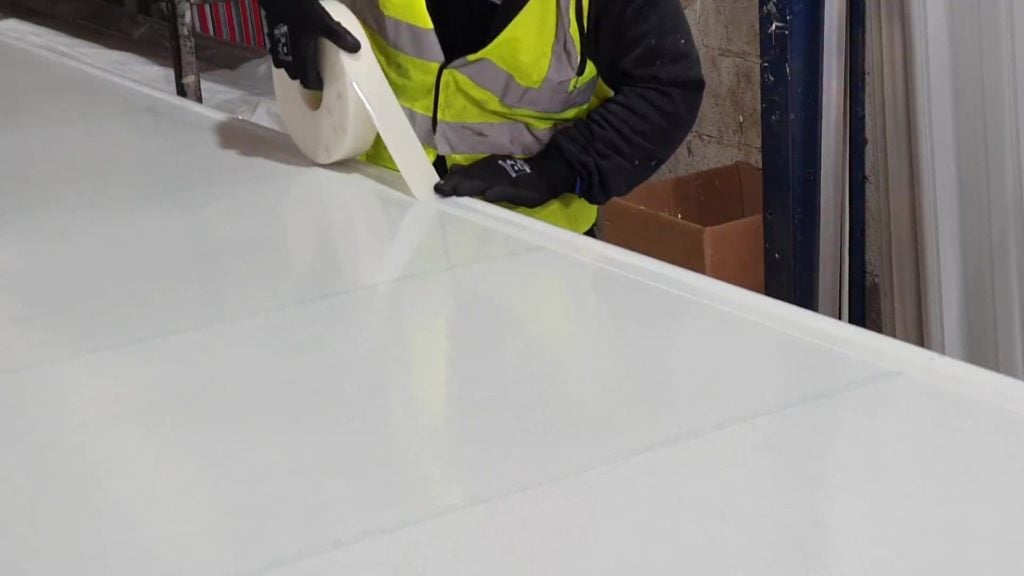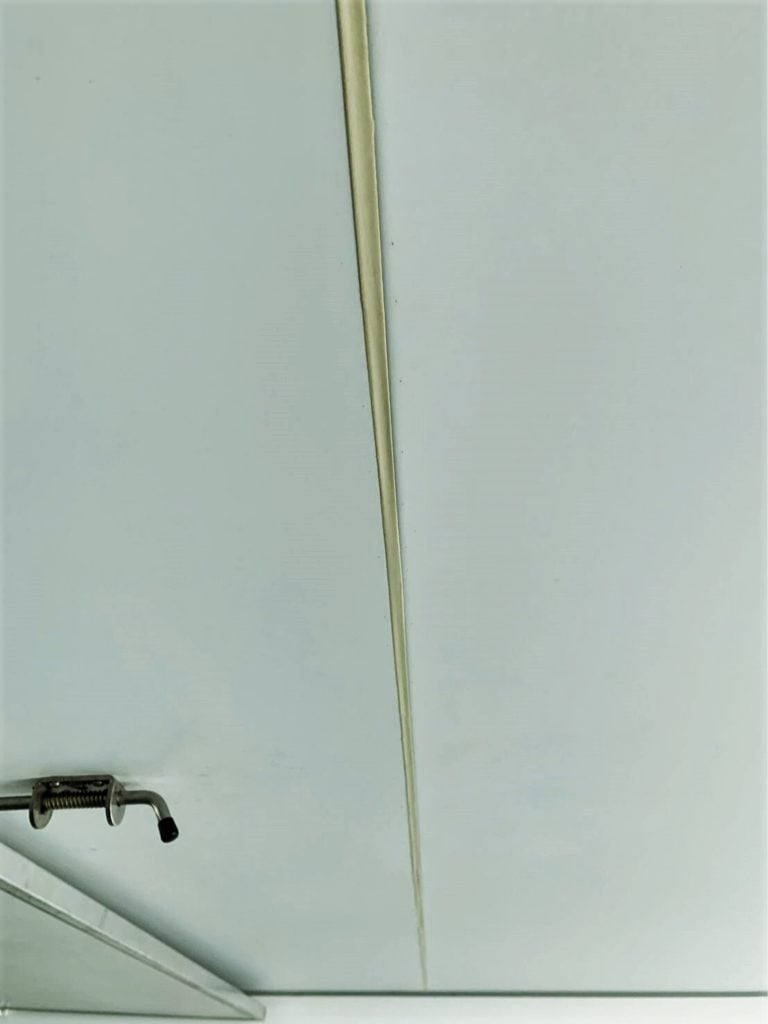
You’ve reached the point where you want to decide which adhesive option is going to work best for you.
Adhesive tape and wet glue are the two of the adhesive options that you can choose from, but which is best for you?
Here at Forgeway, we are specialists in adhesives. We manufacture and supply over 3000 tonnes of adhesive products every year. We have seen the rise of adhesive tape’s popularity over the years.
This article will go over the reason for its popularity and discuss some of the benefits and drawbacks of both options. By the end of the article, you will have a good idea of which option is best for you.
What do ‘adhesive tape’ and ‘wet glue’ mean?
First of all, we should determine what we mean when discussing ‘adhesive tape’ and ‘wet glue’.
Adhesive tape is acrylic adhesive that is pre-applied on one or both sides of a carrier (usually foam). The tape is then attached to two substrates with the aim of holding them together.

Wet glue is the adhesive itself that hasn’t been applied to any carrier. This adhesive is then applied to two or more substrates where it cures and forms a bond. There are other names for wet glue, but structural adhesives is the main term used to describe them.

To produce a fair comparison, we will be talking about using adhesive tape or wet glue for structural situations. A typical example of this is bonding external cappings or joints on vehicles. In this article, we will be using this example for comparing the two options.
However, there are a few other examples of where you could consider using wet glue or adhesive tapes:
- Bonding parts of vehicles together in the automotive industry
- Bonding aluminium composite panels in the construction industry
- Bonding glass in the transportation industry.
Advantages of using adhesive tape
The main reason behind tapes’ popularity is speed. However, there are a few other benefits of using adhesive tapes instead of wet glue. We have listed the main benefits below.
- Speed – So soon as you got the surface preparation out the way and you have applied the tape, you will not need to wait long. Adhesives tapes reach 50% strength in the first 20 minutes. This matters because it means you have reached handling strength very quickly.
- Fewer health concerns – There are some health risks associated with certain wet glues (like epoxies and polyurethanes). Aside from the activators and cleaners you will need to use, the adhesive tapes themselves contain no dangerous chemicals.
- Good holding power for most situations – This holding power is often evaluated when determining whether to use adhesive tapes or mechanical fasteners. This article isn’t comparing that though, we wrote a separate article comparing mechanical fasteners vs adhesives. But the strength of some adhesive tapes means you can compare them side-by-side against wet glue. Ultimately, they have sufficient strength to bond in a variety of situations.
- Quick and easy to apply – When using adhesive tapes, there is very little mess. However, you cannot say the same about wet glue. You will almost always have to clean excess wet glue off the surface of the substrate. This means it can be difficult to get a good finish with wet glue. Adhesive tapes do not require much skill to get a good finish. It is easy to apply and most operatives will be comfortable with using it with no prior training.

Disadvantages of using adhesive tape
After reading those advantages, you may be thinking it’s a no-brainer? Adhesive tapes are easy to use and are fast too, so why wouldn’t you want to use them.
Before you make any decisions, you should also be aware of some of the drawbacks of using adhesive tapes.
- Adhesive tapes require extensive surface preparation – Whilst you will need to do this surface preparation with some wet glues (like epoxies), all adhesive tapes will need extensive surface preparation. This means you will need to clean the surface and then use an activator to maximise strength.
- You need a level/flat surface – Adhesive tapes have limited gap-filling abilities. If the substrate has any dips or the gap between substrates isn’t even, the tape will not be able to fill the gap and will not adhere to both surfaces.
- Temperature-sensitive – Some wet glues are also susceptible to temperature change, but all tapes will not achieve the stated strength if the application environment temperature drops below 21℃.
- They will not always be strong enough – We mentioned above that the strength is sufficient for most bonding situations, but not all bonding situations. Sometimes you will need to use mechanical fasteners and adhesive tape to get the desired strength. The strongest tape can only achieve 1/5th of the strength a wet glue can achieve.
- Adhesive tapes never set – The adhesive on the tape is a very high viscosity liquid that never sets. This means that the tapes are pressure sensitive and will require something to hold them in place while they cure.
- Susceptible to plasticizer/styrene migration – This doesn’t affect all tapes, but most will be at risk of plasticizer migration. This is particularly the case if you are using adhesive tapes to bond GRP or plastics.

Advantages of using wet glue
Wet glue (in particular structural adhesives) replaced mechanical fasteners and welding as the joining method of choice in the manufacturing sectors (automotive, transportation etc). But are adhesives tapes in the process of taking over wet glue?
Maybe, but there are several advantages of using wet glue that would suggest this isn’t the case.
- Wet glues are very versatile – There are so many different types of wet glue. The phrase ‘whatever tape can do, wet glue can do better’ is often used. Whilst it isn’t always true, it does hold some merit. There are only a few occasions where you won’t be able to find a wet glue that can meet your needs.
- The strength is unparallelled – We have touched on strength a few times already, but wet glue is very strong. There are even situations where it is able to replace welding for strength. The strongest wet glue was 10x stronger than adhesive tapes when compared side-by-side.
- Doesn’t require a flat/level surface – Because wet glue is liquid (obviously), it is malleable and can fill any gaps or imperfections between the two substrates you are bonding. This means there will be adhesion all along the joint, and will also ensure the gap is properly sealed too.
- Wet glue can have a high grab – Some wet glue will be able to hold the substrates in place without additional support while they cure. All adhesive tapes are pressure sensitive so they will need clamps or mechanical fasteners to keep them in place while they cure.
- Can require less surface preparation – Some glues are completely primerless. This means you won’t need to place any activator on the substrate before applying the glue. You should always clean the surface before applying tape or glue if you want anything close to its strongest bond. However, some glues (methyl methacrylate adhesives) are able to cut through contamination if the surface wasn’t cleaned properly.
- The cure is durable – With adhesive tapes, you will sometimes face problems with plasticizer/styrene migration. However, wet glue is resistant to this migration. Once it has cured, it is very durable. Some glues have additional chemical resistance properties too. This means that wet glues are not only stronger but are more likely to retain that strength too.

Disadvantages of using wet glue
As we manufacture and supply adhesives on a large scale, we are aware that wet glues also have a few drawbacks too.
- Can be difficult to apply – We have already touched on wet glues’ tendency to cause excess and wastage. But this is part of a wider issue. Some wet glues are difficult to apply correctly and you will likely need to train the operatives before they use them (if they don’t know already).
- The cure time is long – Wet glues can take days to fully cure. Some glues cure faster than others and there are several factors that could be affecting the cure time. However, the majority of glues will take longer to reach handling strength than adhesive tapes.
- There may be health risks – Some wet glues will have some health risks involved when using them. This is due to the chemicals that adhesive manufacturers use to create the adhesive product. As we mentioned earlier, adhesive tapes will not pose this threat.
- Can be difficult to get the right substrate-adhesive match – Some wet glues will not bond to certain substrates (for example LSE plastics like polypropylene). You need to make sure the wet glue is the right one for the substrate and meets your needs as well as those of the operatives using the glue.
- Some wet glues are susceptible to yellowing – The issue of yellowing is most apparent in sealants when they are exposed to UV and other forms of weathering. This yellowing can become an issue because it can lead to degradation that eventually breaks down the bond.

Are adhesives tapes or wet glue the best option for you?
You want to know which option is best for you. After reading this article, you should have a pretty good idea of which option is best for you. If you are still unsure about which would be best, our advice would be to use wet glue. That may seem biased as we are adhesive manufacturers, but there is good reason for that opinion.
Wet glue is the tried and tested method and is much stronger than adhesive tapes. The massive variety of wet glues available will mean there will be one that suits your other needs too.
However, if you want the easier option and are not as concerned about strength, we would recommend you pursue adhesive tapes as a possible solution.
If you are still stuck on which option would be best for you, you can reach out to a member of our team who will be able to guide you to which option is best for you.
Thomas is the Content Manager here at Forgeway. Thomas' job is to translate the technical jargon from the ivory tower of academia into easy-to-read content that everyone can understand. Forgeway's mission is to answer every question our customers and prospective clients ask, or are apprehensive to ask.



